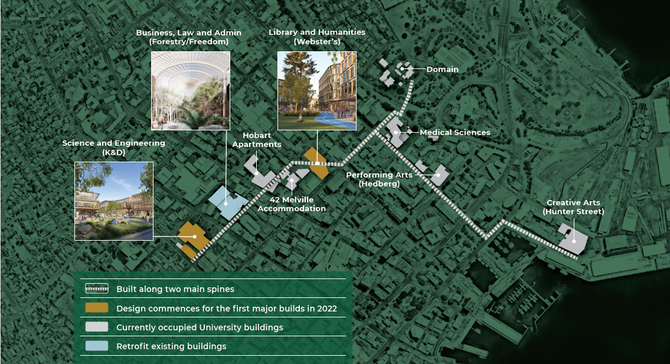I spent four years as an undergraduate at the Domain followed by two years as a post-graduate at Sandy Bay. I regretted the move and was never impressed by the new suburban campus.
Not surprisingly then, I have followed the ongoing controversy about the projected development with considerable interest. I was delighted that the University was returning to the central business district, believing that it would be good for both Hobart and the future of tertiary education.
I have been impressed by the persistence and the passion of the opponents of the move, but have failed to see much cogency of their chorus of complaints.
There seems to be an impression that there is something unusual, even exceptional, about the decision to relocate. But nothing could be further from the truth.
Many of the universities established on suburban, green field sites, in the nineteen sixties and seventies, have moved at least part of their operations to down town locations.
A good example is Deakin’s move into Geelong from their idyllic rural location as early as 1996, when they acquired the historical wool stores on the harbour and won numerous architectural awards for their creative adaption of the vast interiors, along with public applause for the way they revivified the life of the city.
But closer to home developments in Launceston and Burnie also have lessons for us as well. Until recently both campuses were located in suburban sites – Burnie on Mooreville Road and Launceston at Newnham. They both had collections of functional, but quite undistinguished buildings. Burnie has now moved into their new and impressive site at West Park. The building of the new Launceston campus at Invermay is underway.

Masterplan showing the five interconnected precincts of the city-based campus in nipaluna/Hobart.
I am not aware that there has been any public lament for the old locations of the kind we hear endlessly in relation to Sandy Bay. And the result will be that both Launceston and Burnie will boast buildings of greater architectural distinction than any among the often poorly cited and pedestrian structures in Hobart. There also seems to have been a far greater appreciation in the northern cities of the overall benefit of having the University in the city, and not tucked away in the suburbs.
One thing that intrigues me is why the hostility to the return to the city has arisen when the process had been already underway for some time. Important parts of the University are already there downtown. All the Creative Arts and Media, and much of Health and Medicine, are already in place. I am not aware of any public criticism of the location of the Art School on Hunter Street, The Hedberg, Menzies, the College of Nursing, or IMAS.
They seem to be exactly where they should be. So why anyone would object to the Humanities, Social Sciences, Business, Economics and Law, for instance, coming to join them is hard to fathom – and has never been explained.
Once that relocation has been consummated it will be time to begin building the new University library which would be the most significant development of all.
What a priceless contribution to the city the University library will be, a monument to Hobart’s standing as a great city of literature. It has always struck me how few local people are aware of the library and few have ever been there.
In the centre of the city, fronted by a planned public square, it would signal to the world how Hobart had been transformed. In a small area, visitors would find within easy walking distance the University, the State Library, the Museum and Art gallery, the Federation Concert Hall, the Salamanca Art Centre, along with the private art galleries and retail outlets specialising in Tasmanian craft.
It is as well hard to see why anyone should object to the return, after sixty years, to the hitherto abandoned Domain site. The restoration of what is now called Domain House can only be applauded. It is the University’s only significant historical building with a gravitas that the Sandy Bay site has never been able to acquire. It was built in 1850 to house Hobart’s first public secondary school and was acquired by the University in 1892.
But is the relocation worth the all the trouble?
Well yes, there is no doubt Hobart itself will be the long term beneficiary of the move.
There is evidence, both abundant and incontrovertible, from many parts of the world that investment in cultural infrastructure has significantly boosted the fortunes of cities of all sizes.
It has been particularly important for ones in danger of stagnation because of their small size and/or isolation. And this is the challenge facing Hobart. How will it be able to keep its brightest young people in a society with a generation’s long history of outward migration? How will it compete with the mainland cities to attract the most able and enterprising migrants?
A transformed CBD, as planned by the University, will set Hobart up for success in the 21st century.
Find out more about the southern campus we're creating in the city-centre of nipaluna/Hobart.